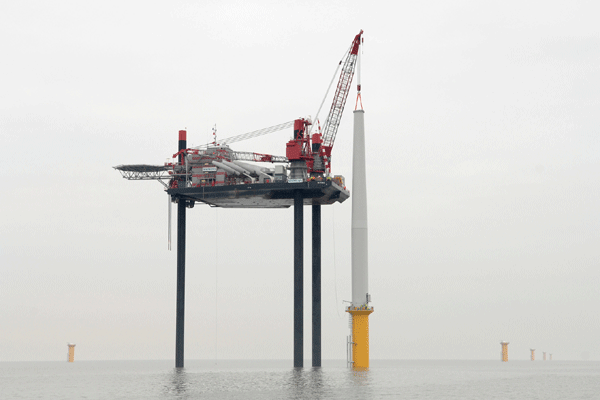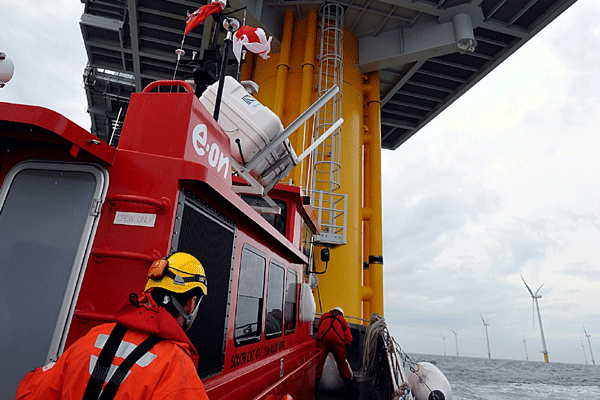Wind Farms – Installation Methods
Life cycle stages
Lease award and Pre-construction
Once a developer has obtained a lease from the Crown Estate they will start to appraise the zone or lease area. This requires a number of surveys to be completed including boat or aerial based bird and marine mammals surveys, benthic grabs and fish surveys.
In addition, data on meteorological factors such as wind speeds, tides and waves is collected, usually through a met mast and wave buoys. This data is used to help the wind farm developer to design the project and help support the consent application.
Once consent is granted more detailed geotechnical and geophysical surveys will be undertaken.
What will I see on the water?
In this stage, there will be increased vessel traffic on site as survey activity is completed on the potential site and cable route. A met mast fixed structure may also be installed. There may also be floating wave buoys or in the future floating wind speed measuring devices called LIDAR.
Construction
Once a wind farm enters construction there will be a huge amount of activity, with the potential for up to 50 boats to be working on the wind farm at any one time. The types of vessels could include:
- Substation Installation Vessel – often a heavy lift crane vessel. This transports and lifts the substation onto the pre-installed foundation;
- Foundation installation vessel – the type of vessel used will vary with foundation type. For monopiles and jackets the most common type of vessel are purpose designed jack up vessels. These vessels will often transport the foundations from the quay side to the site and secure them to the seabed, usually by piling. Gravity base foundations are perhaps easier to install and can use less specialist barges to put them in position;
- Turbine Installation vessels – usually purpose designed jack up vessels or large dynamic positioning vessels. These vessels tend to transport the turbines from the quayside and install them on top of the foundations. The tower is installed first and then different turbine manufacturers install the nacelle and blades in a variety of ways. 12 such vessels were ordered 2011;
- Array and export cable laying vessels – Although the same vessel can be used for both, the export cable is larger and so requires a bigger carousel. Barges can be used although it is becoming more common to see large purpose built dynamic positioning vessels. The cables are usually ploughed into the seabed, although in more difficult terrain ROVs or mattressing/rock dumping can be used; and
- Sea-based support – a range of vessels are used to support the installation process. These include crew vessels, anchor handling, barges, dive support and ROV handling.
| Wind Turbine Installation |
|---|
 |
What will I see on the water?
Lots of activity. The site should be considered a construction site and should be avoided at all times due to the increased Health and Safety risk. During construction a 500m rolling safety zone is placed around the main installation vessels.
There will also be periods where only the foundations have been installed. These may only be a few meters above sea-level and, although they will be marked appropriately, can be difficult to see and pose a health and safety risk.
In line with UNCLOS, (The United Nations Convention on the Law of the Sea), cable installation vessels typically request a 1nm vessel safety zone when installing or handling cables.
Operational
Once a wind farm is operational then the wind turbines will have been installed. The developer can apply to DECC for a 50m safety zone around the wind turbines in which other craft are not supposed to enter (for their own safety).
The site will be serviced by smaller crew transfer vessels, typically up to around 24m long and carrying 12 technicians. Technicians traditionally access turbines by vessels pushing up against the turbine ladder and a technician will then step across. New access techniques are being developed at the moment.
Helicopters may also be used to access the wind turbines, winching down technicians onto a specially designed platform on the nacelle of the wind farm.
Occasionally more major maintenance work may be carried out. This will require a larger installation vessel.
What will I see on the water?
The wind farm. Increased day to day small vessel traffic with technicians accessing the turbines. If there is major maintenance work ongoing then larger installation vessels may be on site.
| Maintenance of Wind Farm Structure |
|---|
Disclaimer
TO DOWNLOAD THIS FILE, YOU MUST AGREE TO THE TERMS AND CONDITIONS "TERMS" NOTED AT THE FOOT OF THIS WEBSITE WHICH APPLY TO YOUR USE OF THIS WEBSITE AND TO USE OF THE FILE YOU HAVE CLICKED TO DOWNLOAD. IF YOU DO NOT AGREE TO THE TERMS, YOU WILL NOT BE ABLE TO DOWNLOAD THE FILE AND YOU SHOULD NOT USE THIS WEBSITE. TO CONFIRM YOUR ACCEPTANCE OF THE TERMS AND TO COMMENCE THE DOWNLOAD OF THE FILE, PLEASE CLICK THE "DOWNLOAD" CHECK BOX. IF YOU DO NOT AGREE TO THE TERMS, PLEASE CLICK THE "CANCEL" BUTTON. YOUR ATTENTION IS DRAWN TO CONDITION 3 NOTED BELOW WHICH FORMS PART OF THE TERMS IN RELATION TO OUR LIABILITY TO YOU.
Agree and download Cancel





